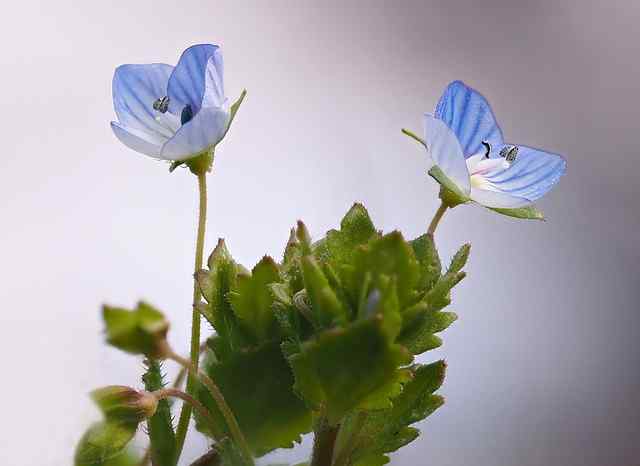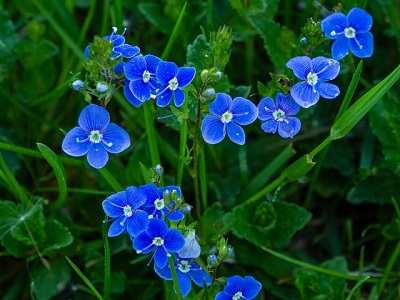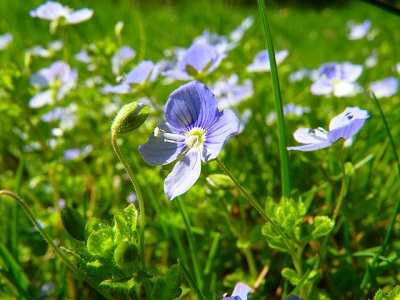Veronica plants are low-maintenance, colorful garden plants. Gardeners love speedwells for their beautiful blue or purple blossoms and adaptability. This blog article will teach you how to cultivate and care for Veronica plants so you may enjoy their beauty in your yard for years. For healthy Veronica plants, we’ll discuss soil, watering, trimming, and propagation.
Veronica Plant Care
Maintaining your Veronica plant is crucial to its health. Choosing the right planting spot, watering, feeding, and trimming your Veronica plant is worth it. This video will cover all the essential Veronica plant management issues to help you keep your plant vibrant and lush.
Light
Veronica plants need six hours of direct sunshine daily. If you don’t have full sun, they’ll accept partial shade. Veronica is a resilient, easy-to-grow plant. Plant them in full or half-sun with wet, well-drained soil for optimal results. Give your Veronica plants enough sunshine and well-draining soil to grow and blossom.
Soil
Veronica thrives on well-drained, organic-amended soil. Veronica plants are versatile and may thrive in clay or sand-heavy soil. They withstand neutral, alkaline, and acidic soil pH. Veronica plants are low-maintenance, multipurpose plants that may grow in a range of soil types and pH levels.
Veronica Speedwell is ideal. These plants flourish in full sun to mild shade. Veronica Speedwell thrives on loamy, sandy, and clay soils. Veronica Speedwell adds color and charm to a garden in a sunny place with well-draining soil or a somewhat shaded site with heavy soil.

Water
Once planted, Veronica Speedwell is drought-resistant. To guarantee optimum development and bloom, water Veronica Speedwell if there is less than an inch (2.5 cm) of rainfall each week in summer. If it’s been dry, plants in full flower may need more water. Veronica species that are lower-growing and can tolerate dry conditions are suitable for rock gardens. Veronica Speedwell thrives in dry, sunny areas and rock gardens.
Temperature and Humidity
Veronica grows best around 60–80°F. Yet, this resistant plant can tolerate lower temperatures and flourish in many places. Veronica is suggested for USDA hardiness zones 4-8, which includes much of North America and southern Canada.
Veronica prefers moderate humidity but may grow in many environments. Make sure the soil drains adequately and the plant gets consistent hydration. Provide Veronica the right circumstances to develop and blossom.

Fertilizer
As they’re light feeders, Veronica plants are low-maintenance and don’t need fertilizing. Before planting and every other spring, add compost to the soil. This will nourish the plant. Just add new compost and water the plant. This easy method keeps Veronica plants healthy without fertilizing.
Veronica adds beauty to your yard with its spiky purple blossoms. This plant is perfect for borders or bulk plantings in sunny gardens since it only grows 12-18 inches tall. EarthPods or FitLeaf Plant Energy Bloom, applied monthly throughout the growth season, are ideal fertilizers for Veronica plants. Veronica plants bring color to any garden with appropriate care.
Here is my recommended fertilizers:
EarthPods Organic Fertilizer – Shop from Amazon
Fitleaf Plant Energy Bloom – Shop from Amazon
Pruning
Pruning keeps Veronica plants looking good. Deadheading wilted flower spikes during bloom season encourages branching and flowering. This helps the plant bloom all season. Shear the plant to the foliage if it seems straggly.
Following the first deadly frost, trim all foliage to a few inches from the ground. This prepares the plant for winter and promotes spring development. In mid-June, prune taller Veronica varieties. During early to mid-June, trim 6 inches from the mature plant with sharp gardening scissors. This promotes plant health and form.
Pruning helps Veronica plants grow and bloom year after year.
Here is my best pruner That I use for my flowering plants:
Professional Pruning Shears – Shop from Amazon
Propagation
Veronica plants can be propagated by cuttings, seeds or division method. Dividing every three or four years in early spring or autumn is a frequent approach. This will keep plants strong.
Lift the root ball with a shovel to divide. Divide it into root-and-top-growth portions using a sharp spade. Handle the plant gently to prevent injuring the roots or top growth. Replant the divisions in your garden or containers after dividing the plant. This will give the new plants room to grow.
Cuttings may also propagate Veronica plants. A healthy plant cutting is rooted in soil or water. Seed propagation of Veronica plants takes longer and needs more attention. You may extend your garden and enjoy Veronica plants year after year by propagating and caring for your new plants.
Veronica Plant Varieties

- Veronica ‘First Love’: Early summer blossoms become pink in October. It tolerates heat, drought, and cold and grows 10-12 inches. Plant it in spring or autumn in USDA zones 4-9.
- Georgia Blue (Veronica umbrosa ‘Georgia Blue’): Early spring and summer blooms are vivid blue. Heat and drought-tolerant, it grows to 4-6 inches. Plant it in April in USDA zones 4-8.
- Giles van Hees (Veronica spicata ‘Giles van Hees’) produces purple-blue blooms in early to mid-summer. It tolerates heat, drought, and cold and grows 12-18 inches. Plant it in spring or autumn in USDA zones 3-9.
- Royal Candles (Veronica spicata ‘Royal Candles’): Mid- to late-summer blooms are rich blue-purple. Heat and drought-tolerant, it grows 18-24 inches. Plant it in April in USDA zones 4-8.
- Sunny Border Blue (Veronica ‘Sunny Border Blue’): Early summer blooming spikes of bright blue blooms. It tolerates heat, drought, and cold and grows 24-30 inches. Plant it in spring or autumn in USDA zones 3-8.
- Vernique Blue (Veronica ‘Vernique Blue’): Early summer blossoms are gorgeous blue. It tolerates heat, drought, and cold and grows 10-12 inches. Plant it in spring or autumn in USDA zones 4-9.
- Vernique Shining Seas (Veronica ‘Vernique Shining Seas’): Early summer blossoms are vivid blue. It tolerates heat, drought, and cold and grows 8-10 inches. Plant it in spring or autumn in USDA zones 4-9.
- Whitewater (Veronica) blooms early to mid-summer with spikes of white flowers. It tolerates heat, drought, and cold and grows 12-18 inches. Plant it in April in USDA zones 4-8.
Check out – Speedwell Veronica Flower meaning.
How To Grow Veronica Speedwell From Seeds

Growing Veronica Speedwell from seeds is enjoyable and gratifying and may produce magnificent flowers in a few months. Start here:
- Sow Veronica Speedwell seeds in a small container with potting soil indoors. Press the seeds into the dirt and gently cover them.
- Place the container in a sunny location or use grow lights to give the seeds enough light. Keep the soil moist but not soggy to avoid seed rot.
- Germination takes 14–21 days. Maintain soil moisture and light when seedlings sprout.
- After a few inches, seedlings may be put outdoors. Plant in full sun or moderate shade.
- Frost may destroy Veronica Speedwell, so plant it during the frost-free season.
- Place the seedling in a shallow hole and cover the roots with earth. Allow 12–18 inches between plants for growth.
- Water seedlings freely and consistently during the growth season.
These easy techniques will let you produce stunning Veronica Speedwell plants from seed and enjoy their wonderful blossoms in your yard or as cut flowers.
You can buy seeds from here –
Veronica Spiked Speedwell Seeds – Shop from Amazon
Creeping Speedwell Seeds – Shop from Amazon
Veronica Plant winter care
Veronica Speedwell is hardy and versatile, growing in zones 3–9. This makes it ideal for gardeners in cold northern and mild southern climates. Winter veronica care tips:
- Veronica Speedwell leaves should be pruned down to 2 inches from the ground in cold weather. This conserves energy and prepares the plant for winter.
- Keep soil wet but not soggy throughout winter. This prevents root dryness.
- To promote spring growth, deadhead the plant.
- Protect your Veronica Speedwell if you live in a cold climate. Mulch or straw helps protect the plant from cold.
- Veronica Speedwell normally becomes dormant in winter, so don’t worry if it seems dead. Spring revives the plant.
- Whenever the temperature warms up, check for fresh growth. After new growth, hydrate and fertilize as usual.
Following these instructions will help your Veronica Speedwell survive winter and grow stronger in April.
About Veronica Plant
Veronica spicata is a useful and low-maintenance garden plant. It will enhance rock gardens, border beds, and foundation plants. It attracts bees and butterflies with its tall spikes of exquisite petals in a variety of hues and its capacity to bloom from spring to October. Fresh-cut Veronica blossoms are extremely lovely.
Veronica resists deer and rabbits, making it great for gardeners who battle with animal damage. Veronica prostrata, a bushy ground cover, is only 10 inches tall, although bigger variants may reach 3 feet. Veronica can enhance any landscape regardless of size.
People Also Ask
Do Veronica plants spread?
Garden Veronica plants self-seed quickly. Collect the seed heads and sow them to restrict their development. Plant Veronica 1–2 feet apart, depending on variety size. Young plants must be well-watered to create strong roots. Veronica plants are drought-tolerant and just need a little covering of compost in the spring.
Is Veronica plant toxic to dogs?
Pet owners may wonder which plants are safe. The American Organization for the Prevention of Cruelty to Animals says the Veronica plant is non-toxic to cats, dogs, and cattle (ASPCA). Veronica plants are safe for dogs to eat. If your pet exhibits strange symptoms among plants, notify your vet.
Where should you plant Veronica?
Veronica plants like wet, well-draining loam soil with an acidic, alkaline, or neutral pH. Plant them in broad sun or slight shade. These adaptable plants are ideal for cottage and informal gardens as edging, flower beds, and borders. Choose a sunny position with rich, well-draining soil for best development. Early watering helps Veronica plants become drought-tolerant. Too much shadow might reduce flowering.
Is Veronica a good ground cover?
Each Veronica ground cover kind has distinct features. The evergreen perennial creeping speedwell (Veronica repens) creates a low-growing carpet of glossy leaves on spreading stems and is a popular ground cover. This kind is perfect for rock garden gaps and garden path pavers.
Turkish speedwell (Veronica liwanensis) may also generate a “lawn” impression like thyme. This type has a thick mat of small green leaves and spring blue blooms.
The creeping speedwell, Veronica filiformis, produces a thick carpet of greenery for rock gardens and footpaths. Its tiny, spherical leaves and lovely blue blooms make it a garden favorite.
Does Veronica flower all summer?
Several Veronica species bloom from late spring or early summer until fall, creating magnificent spikes of flowers. Veronica’s long-lasting purple, blue, pink, or white blossoms give color and visual appeal to any garden. Veronica is a popular low-maintenance, long-lasting plant since it blooms for months.
Will Veronica rebloom after deadheading?
Veronica plants should be deadheaded to keep producing blooms. Veronica spikes grow in waves. Deadheading involves clipping off spent flowers at their bases. This encourages summer and autumn flowering.
In addition to deadheading, Veronica plants need two forms of trimming annually. Summer deadheading encourages blossoming. The second method is trimming back dead plant material in autumn or early spring to encourage new growth and form.
Can Veronica be grown in pots?
Smaller Veronica plants are wonderful for container gardening. Nonetheless, the pot must be big enough for the plant’s root system and the variety’s maturity size. Choose a container with drainage holes and high-quality potting mix to guarantee optimum drainage and nourishment. To promote healthy development and flowering, water and fertilize container-grown Veronica.
Here are names of small veronica varieties:
- Veronica gentianoides ‘Variegata’
- Veronica umbrosa ‘Georgia Blue’
- Veronica gentianoides
- Veronica ‘Ellen Mae’
- Veronica spicata ‘Ulster Blue Dwarf’
- Veronica gentianoides ‘Mountain Breeze’
For those who have large space, gardens for veronica speedwell flowers. Here is the list of tall veronica plant varieties:
- Veronica oltensis
- Veronica spicata ‘Rotfuchs’
- Veronica spicata ‘Glory’PBR
- Veronica spicata
- Veronica longifolia
- Veronica ‘Pink Damask’
- Veronica × media First Love (‘Alllove’PBR)
- Veronica longifolia ‘Marietta’PBR
You can buy seeds for the most popular and used Speedwell (Veronica):
Final thoughts
I hope you liked the article and get all the information about Veronica plant (Speedwells).
